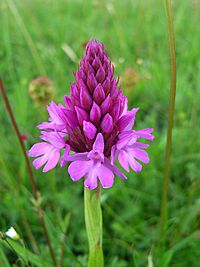Rough Bank, Miserden facts for kids
| Site of Special Scientific Interest | |

Example - pyramidal orchid (Anacamptis pyramidalis)
|
|
| Area of Search | Gloucestershire |
|---|---|
| Coordinates | 51°46′38″N 2°08′08″W / 51.77734°N 2.135474°W |
| Interest | Biological |
| Area | 9.2 hectare |
| Notification | 1986 |
Rough Bank, Miserden is a special natural area in Gloucestershire, England. It's about 9.2 hectares big, which is like 22 football fields! This place is so important for nature that it was named a 'Site of Special Scientific Interest' (SSSI) in 1986. A group called Butterfly Conservation bought it in 2012 to help protect it.
Contents
What is Rough Bank, Miserden?
Rough Bank is located in the beautiful Cotswolds, close to a village called Miserden. It's a very old grassland area, full of different kinds of plants. The ground here is made of 'Jurassic limestone,' which is a special type of rock from a very long time ago. This kind of soil helps many unique plants grow.
Amazing Plants and Flowers
The grassland at Rough Bank is home to many interesting plants. You can find grasses like upright brome, tor-grass, and sheep's fescue. Many other plants that love limestone soil also grow here, such as autumn gentian, clustered bellflower, common calamint, ploughman's spikenard, and rock rose. There's also a lot of kidney vetch, which is a favorite plant for many insects.
Beautiful Orchids
Rough Bank is famous for its amazing collection of orchids. Many different types grow here, including the fly orchid, bee orchid, green-winged orchid, fragrant orchid, and the greater butterfly orchid. You'll see tons of Pyramidal orchids, too!
Woodland Plants
Some parts of Rough Bank have woodlands and bushy areas. These spots have their own special plants, like broad-leaved helleborine, white helleborine, and nettle-leaved bellflower. You might even spot columbine growing there.
Why is Rough Bank so Special?
This nature reserve is incredibly rich in wildlife. The main grassland area, which is a Site of Special Scientific Interest (SSSI), is home to:
- 33 different kinds of butterfly
- 42 types of moths that are rare or nationally scarce
- 12 different kinds of orchids
The plants that love limestone, like horseshoe vetch, autumn gentian, clustered bellflower, ploughman's spikenard, and rock rose, make the area very colorful. The large number of orchids, including early purple, fly, bee, fragrant, lesser butterfly, pyramidal, and autumn lady's tresses, is truly impressive!
Rough Bank was bought by Butterfly Conservation in 2012. They got help from Natural England, The Gloucestershire Naturalists Society, and many kind people who donated money. Now, it's part of the Cotswolds Commons and Beechwoods National Nature Reserve (NNR). It's looked after by Butterfly Conservation, Natural England, and the National Trust working together.
Amazing Animals (Fauna)
The many different plants at Rough Bank provide food and homes for a wide variety of invertebrates (animals without backbones). The butterflies you might see include the chalkhill blue, small blue, green hairstreak, and the marbled white. Scientists have also found different kinds of snails, ants, and woodlouse here. You can even see old ant hills in the grassland!
Visiting Rough Bank
If you want to visit, you can take the number 23 bus from Stroud and get off at The Camp. Just remember that buses are not very frequent, so check the timetable before you go.
The entrance to the reserve is at SO914 087, just south of The Camp. The Camp is a small village on a road called Calf Way. This road connects the B4070 (which goes from Birdlip to Stroud) with Bisley. The nearest postcode is GL6 7HN.
When you drive through The Camp onto Calf Way, you'll reach a fork in the road. Turn right, and the entrance will be a few minutes further down the road on your right.
There's a small car park inside the reserve entrance. Be very careful when turning in and out because cars drive fast on this road. Also, watch out for people riding horses on the bridleway. There's no safe place to park on the side of the road, and you should never block the gateway, even if the car park is full, because farm vehicles need to get through at all times.

